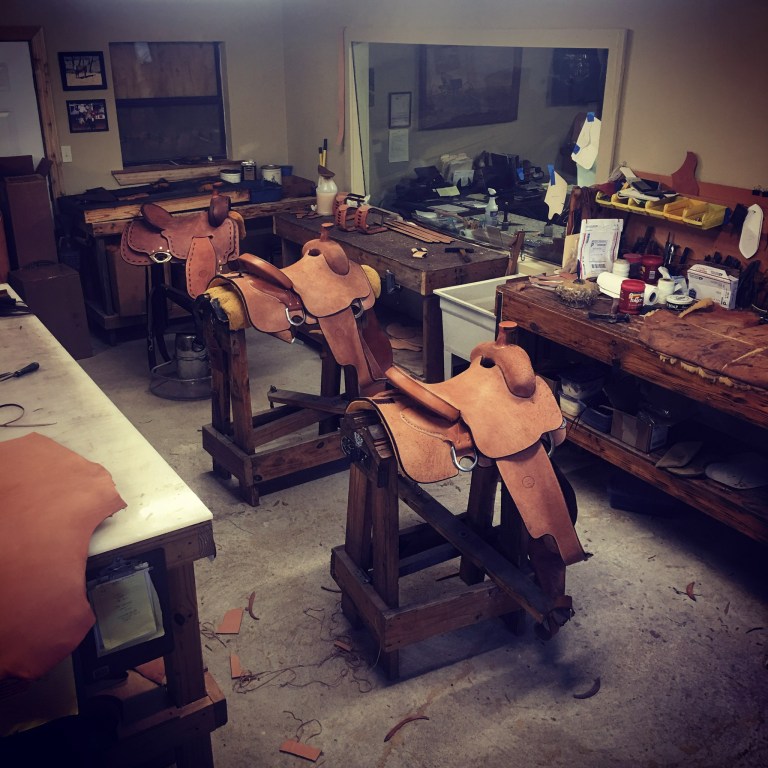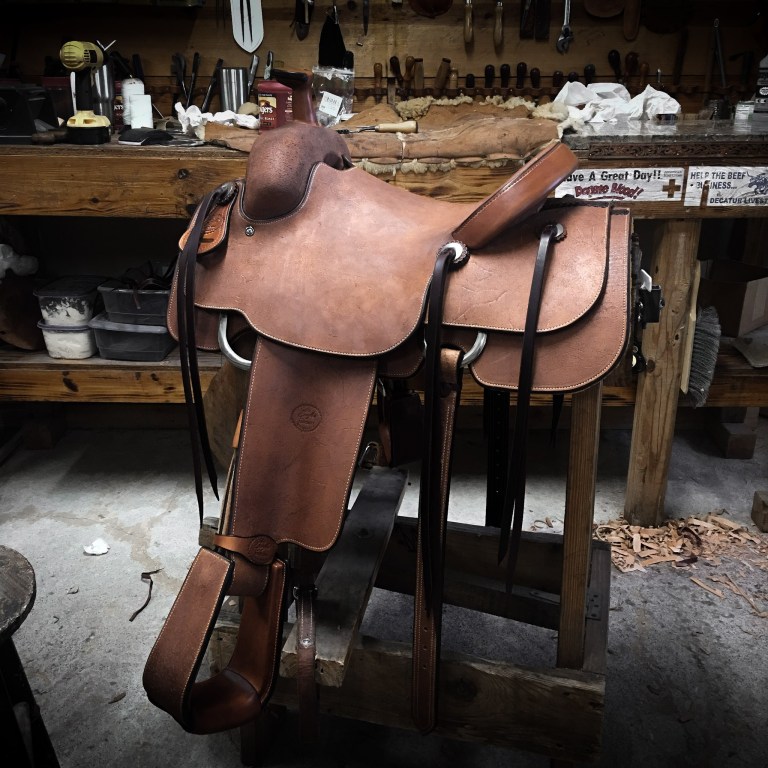
by Gene Fowler
Texas saddlemaker and leather artist Don Gonzales is living proof of the benefits of a family that encourages creative expression and exploration. “I grew up in the Aransas Pass and Refugio area,” he says, “down along the coast, and we had a very creative household. My mom is a nurse who creates artwork out of gourds, and my dad, who passed away in 2013, was always tinkering….like me, I guess,” he adds with a laugh.
Young Don drew things, recreating the comic books he compulsively read like most kids. And that hand-eye skill, over time, became innate. It proves invaluable today in the hand-tooling he embeds on saddles, belts, book covers, and rope bags and cans. The instructional videos he creates for his 25,000+ YouTube subscribers reveal a man who teaches with contagious enthusiasm.
“My love for working with leather began when I was in the eighth grade,” says Don, when asked how he got into his line of work. “I had a roping friend whose dad had a leatherwork shop in the barn. When I would go over there to practice roping, his dad would show me stuff. It didn’t take long before I was hooked.”
The next Christmas, Don got a Tandy Leather kit. “It was the big one,” he remembers. “Had everything in it. That Christmas weekend I made everything in there. And my interest just grew from there.” Fast forward to community college, when Don made a knife sheath for a friend. “Another guy was there when I presented it and said, ‘You made that? How much would you charge to make me one?’ I said $25. He said, ‘Here’s $50. Make me two of ‘em.’ That next weekend I got all my tools together, and from that point on I’ve always had a shop in my house or apartment.”
After community college, he headed to Texas A&M for an undergraduate science degree, intending to continue his education and become a veterinarian. Taking a year off from school, he went to work for saddlemaker Jim Plantt. “We didn’t have any saddlemakers in Aransas Pass,” he says, “and Jim was the first, real full-time saddlemaker I ever met.”
He started out doing saddle repairs and some tooling. “And, after I built a saddle that summer, he offered me an apprenticeship. I ended up not going to veterinarian school and built three or four saddles that first year.” Before long, Jim Plantt (who passed away in 2017) was ready to retire; Don bought the business and its real estate in Bryan, Texas, near College Station and Texas A&M University. That was about 15 years ago. For a while, Don and his team turned out about 30 to 35 saddles a year. Nowadays, downsized to a smaller space in the nearby wide spot of Wheelock, he builds about 15 to 20 with one assistant.

Using Hermann Oak leathers – quality has always been a focus, of course – but with reduced production, Don is upping his game even more in the quality-of-work department. Though many of his pragmatic customers—working cowboys and horse trainers—want rough-out saddles, you don’t have to look far on his website to see some super ornate tooling.
And despite the fact that most of his clients request a more straightforward design and execution, Don has had his share of unusual requests. A Louisiana lady asked to have high-heeled shoes and a princess crown tooled into her saddle, a lip gloss holder built into the flank billet and a pouch behind the cantle to carry an iPhone. One request was not granted—a mirror on the horn cap. “The customer was a team roper,” Don explains, “so that would not have worked. The mirror would have been broken.”
Several years ago, a spur maker surprised Don by telling him that he’d developed a reputation as a saddlemaker who tooled a lot of skull designs. “When did I become ‘the skull guy?” he wondered. But, then he noticed that his shop had been doing a lot of skull themes. Three specific ones came to mind: fire skulls, death skulls and sugar skulls, the last evidently influenced by the trending traditions of Dia de los Muertos. “The skull thing has pretty much died down now though,” he adds.
When Don first began working with Jim Plantt, the elder artisan would solemnly observe that the cowboy gear arts were “dying on the vine,” that too few young people were coming along to carry on the handmade traditions. And Don recalls meeting a total of three students who “dabbled” in gear making during his years at A&M. “And when I first started getting really serious about leathercraft, pretty much all you had was the Al Stohlman instruction books, which were great, but today with social media, it’s just exploding. We’re seeing a leathercraft renaissance with tons of younger people wanting to learn. The ‘maker’s movement’ is huge, and there’s really enough work for everybody.”



The saddlemaker has taught a few in-person classes of 10 to 15 folks, but with two kids at home under the age of five, the time factor has become a problem for face-to-face instruction. Still, teaching has become as big a part of his business as building saddles and tooling belts. “I’ve had guys work for me who are now out on their own and being successful,” he says. “It’s really neat to take somebody that doesn’t know anything and put them in there and see how they grow. I’m a tech-gadget nut, but traditional skills and art need to be preserved and continue. And there’s a real big growth in that market.”
Most of Don’s instruction and sharing is in the form of blog tips and videos on his website and on YouTube. The blogs and videos cover everything from “Painting on Leather” to “Cutting Ears on a Saddle Seat.” A 2015 video titled “Detail Work on Feathers” has been viewed 293,000 times. “Swivel Knife Tutorial” from 2017 has racked up 115,000 plays. “How to Tool Floral Leather Tooling Patterns #2,” posted on February 17, 2019, was screened 658 times in the first three hours it was online.

Don’s blog posts drill down into leather care, leather repair and, of course, all things saddle-y, from fitting to “hard seat vs. soft seat.” Way back in 2013, the blog even posed the trending question, “What is up with all the skulls?” Perhaps a little tongue-in-cheek, the blogger observed, “The days of the traditional oak leaf and acorn floral, the simple basket stamping or the intricate Sheridan-style tooling being the three main options for our selection of artwork available to us are gone,” adding in the next sentence that they do remain the favorites for most Western folks requesting custom work. Citing exceptions, he continued, “We have made belts with wildlife scenes, angel wings, mermaids, barmaids, hot dogs, bullfrogs, cactus, swords, naked ladies…the list goes on and on. But the most popular thing we see people wanting is skulls.” The three skull-themed saddles the shop had built to that point, he noted, “were all three the most popular of all the saddles we have built.”
A post that hit especially close to home for Don concerned caring for leather that had been submerged in water after Hurricane Harvey hit the Texas coast in 2017. “Water alone does not damage leather,” he wrote, “but contaminants in the water will damage leather….Leather being wet is not what causes dry rot. What causes dry rot in leather is when the leather is saturated with water and then allowed to dry and then not oiled.” Having grown up on the coast, Don had many friends and family members asking if saddles and tack were ruined after the storm.
“We donated a showpiece saddle for a hurricane relief fundraiser at the Brazos Valley Fair,” he recalls. “Catalena Hatters donated a 100X felt hat, and Brenham spur maker Scott Sommerlatte donated a pair of spurs to the package. We raised $8,000.”




Though Don notes that leather can be a very “forgiving” substance to work with, he also observes that leathercraft can be “intimidating to the uninitiated.” And one of the most important factors to get right when first starting out (and at any stage of one’s leathercraft development) is the tools selected. One blog post cites his “Top 5 Essential Tools for the Leathercraft Beginner.” They are a sharp point trim knife (“I recommend one made by the C.S. Osborne Company”), a quality spike awl, a daily shop hammer, a sharpening stone and the humble tape measure. An instructional video details the 10 items Don keeps handy at all times on his tool belt.
Coming up, the saddlemaker plans a series of videos on the more advanced nuances of tooling, and down the road he’s got plans to start making his own saddle trees. And, of course, he’ll keep making art, leather and otherwise (check out the fine art prints under DGS Portfolio on his website). “I still like to draw,” he says. “I do a lot of portraits of family and friends. And pretty soon, I may take up oil painting! I like a challenge and learning new things.”
This article originally appeared on Shop Talk Magazine and is published here with permission.
Find more interesting stories in our section on Tack & Farm.
































